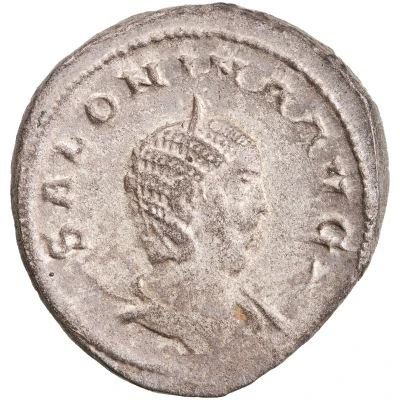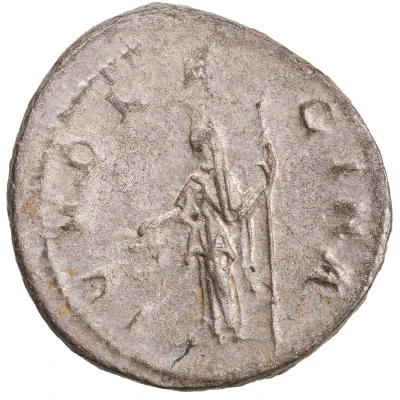Antoninianus - Cornelia Salonina IVNO REGINA; Juno
| Silver | - | - |
| Issuer | Rome › Roman Empire (27 BC - 395 AD) |
|---|---|
| Empress | Cornelia Salonina (Julia Cornelia Salonina) (254-268) |
| Emperor | Valerian (Publius Licinius Valerianus) (253-260) Gallienus (Publius Licinius Egnatius Gallienus) (253-268) |
| Type | Standard circulation coin |
| Years | 257-258 |
| Value | Antoninianus (1) |
| Currency | Antoninianus, Reform of Caracalla (AD 215 – 301) |
| Composition | Silver |
| Shape | Round (irregular) |
| Technique | Hammered |
| Demonetized | Yes |
| Updated | 2024-10-05 |
| Numista | N#289570 |
|---|---|
| Rarity index | 100% |
Reverse
Juno, draped, standing left, holding patera in right hand and sceptre in left hand; sometimes at her feet, eagle. Officina mark in left field.
Script: Latin
Lettering:
IVNO REGINA
Q
Translation:
Iunoni Reginae.
To queen Juno.
Comment
Source:Online Coins of the Roman Empire (OCRE)
Interesting fact
The Antoninianus coin featuring Cornelia Salonina, which was minted during the reign of Emperor Gallienus (253-268 AD), is considered to be one of the most beautiful coins of the Roman Empire. Its design features a portrait of Cornelia Salonina, the empress, on the obverse (front side), and an image of the goddess Juno, who was revered as the protector of the Roman state, on the reverse (back side). The coin's design was meant to convey the message that the empress was a symbol of wisdom, virtue, and maternal care, and that she was protected by the gods. It's worth noting that the coin's design and message were not just aesthetic choices, but also served a political purpose. By portraying Cornelia Salonina as a virtuous and divine figure, the coin aimed to promote the legitimacy and authority of the emperor and his regime. Additionally, the coin's silver content and its status as a standard circulation coin made it a valuable and widely used currency throughout the empire.

